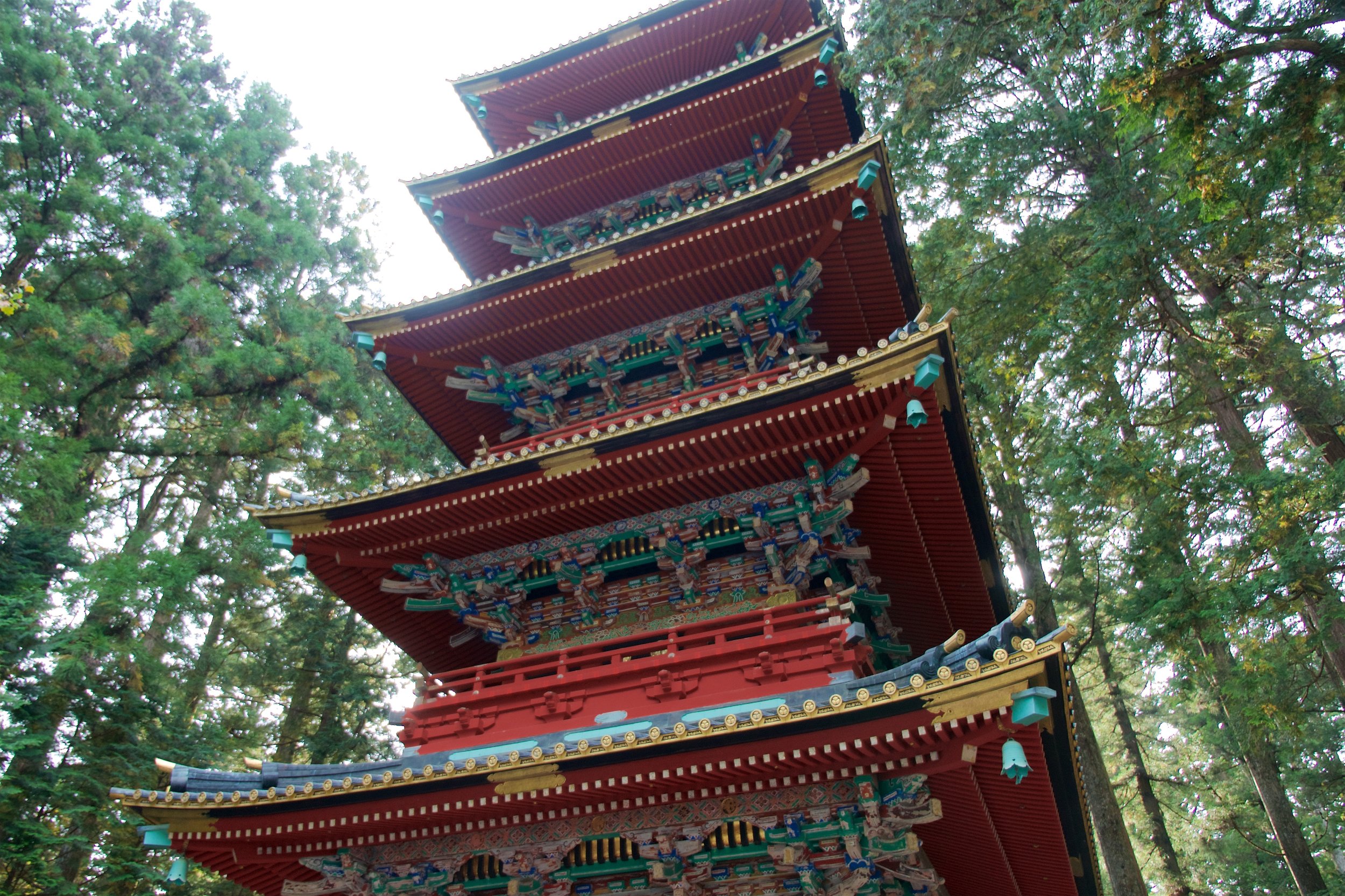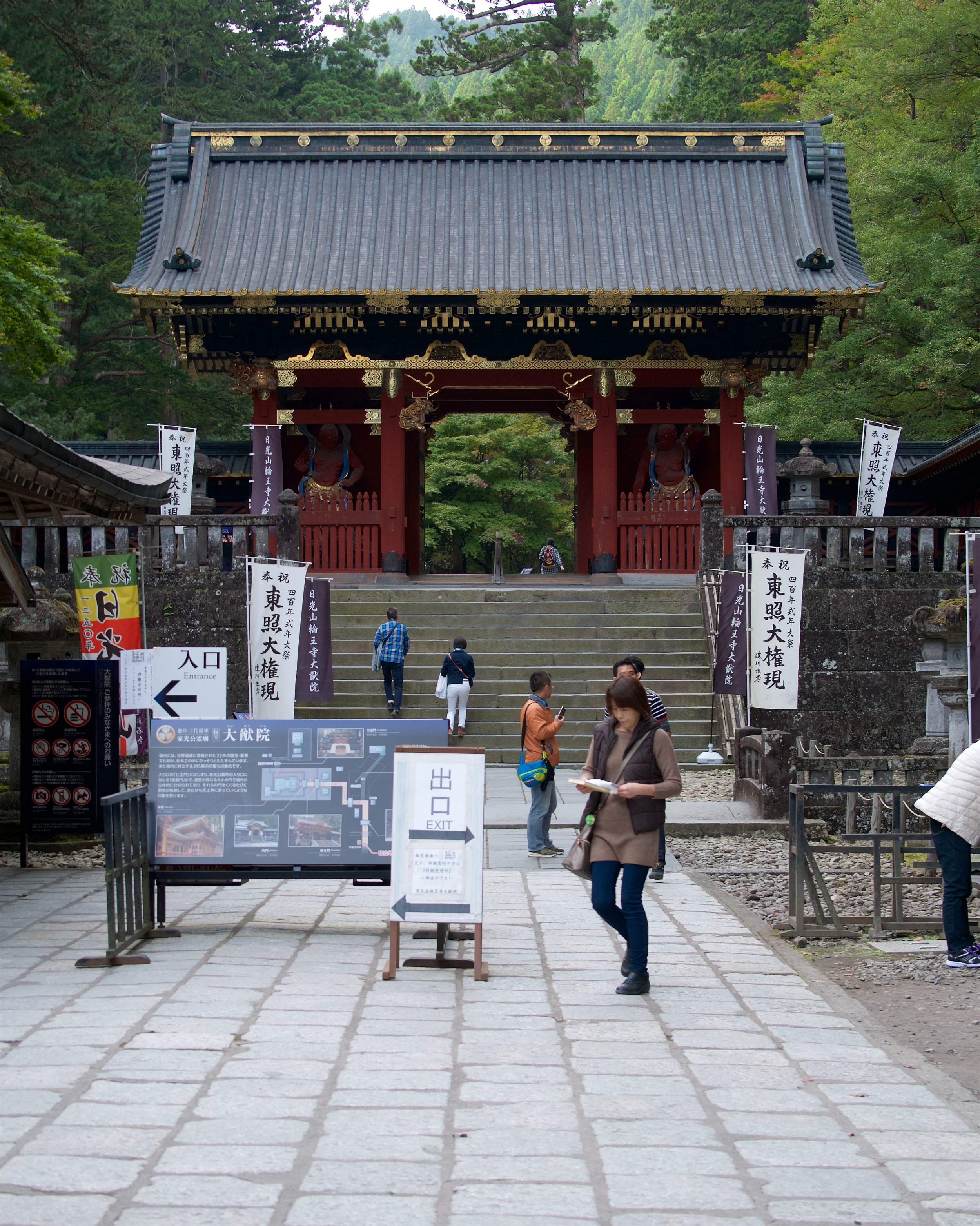Tokyo and Nikko, Friday 21-Oct
We spent most of the day out of Tokyo, going to Nikko to visit Nikko National Park, which houses several prominent shrines and temples. We went to Toshogu Shrine and Taiyuinbyo.
The previous night, we had gotten a bunch of food for breakfast, so we had that, then set out for Asakusa Station. Unfortunately, we first went to the wrong one; the Asakusa Station with the long-haul trains was different than the subway station. Fortunately, we pretty quickly figured out that we weren't where we needed to be, but after asking around, we got directions to the right place. We purchased our train passes to Nikko, then went upstairs to wait for the train (it starts out elevated, then goes down to ground level).
There weren't a lot of people who boarded at our station. We sat across from an older woman who took her seat, got out a bottled drink, worked pretty hard to loosen the cap, then unwrapped an onigiri, and contently ate hear breakfast.
The woman's bottled drink make me think back to all the beverage vending machines I've seen around the city. It's hard to go a block without seeing at least a pair of the machines. They're extremely popular, and it makes me wonder how much work it is to keep them all stocked.
The train ride was not quite two and a half hours, so it seemed it would be pretty luxurious to have so much room. Not so. At the next stop at the Tokyo Skytree (not very far away), a lot of people boarded, and even more over the next couple stops. I still had enough room to write a bit (I had taken my laptop with me), and since I had the wifi hotspot with me, I was able to look things up as needed. Unfortunately, since the cell signal got pretty weak during part of the trip, the hot spot was working overtime trying to acquire a signal, and the battery started running down pretty quickly. I hadn't brought the charge cable, since every other day it never got below 75%. I'd need to be careful with it during the day. In addition, my phone was also running lower. Normally I would use my laptop to charge it, but I wanted the option of using the laptop on the way back, so I instead used by external battery to keep the phone charged.
Our train wasn't a bullet train; the top speed I saw was about 60mph. We'll have the opportunity to be on faster trains later in our trip.
We arrived at Nikko Station, with two of the train's original six cars (the train split at Shimo-imaichi and the other four went to Kinugawa-onsen). Since this was the end of the line, we all got off and entered Nikko.
Nikko
Since it was about 1pm, we were ready for lunch. Even though it would be about a 20 minute walk, we decided to go to a restaurant which was recommended in our guide book, so we headed out. It was certainly a change to be walking in a hilly/mountainous area which was less developed. We walked half the way on side streets, but once we hit the main road, you could definitely tell the business were well placed to catch tourists' eyes.
We were quickly seated at the restaurant, and we were next to a wall with Post-Its pinned onto the wall with notes written by visitors from all around the world, in all sorts of languages. It didn't take long for our meals to arrive, chashu donburi and a yakitori/yakisoba combination. Both were really good.
Fed and happy, we were ready to head to the shrines. We had gone almost half way, so we decided to walk at least to the Shinkyo Bridge, and after looking around there, see if a bus was available after we were done there. Not a whole lot of people were at the bridge, but most of them were taking pictures. Shinkyo, at least the current one, was built in the early 17th century, and is a particularly elegant bridge. We didn't walk across it; few people paid the fee to do so.
With no bus in sight, we started walking up the stairs and roads to Nikko National Park. There are several temples and shrines, so we chose to start with the Toshogu Shrine.
Toshogu Shrine
The founder of the Tokugawa Shogunate, Tokugawa Ieyasu, rests within Toshogu Shrine. That shogunate ruled Japan for two and a half centuries, lasting until the mid-19th century. The mausoleum was initially the only part of the shrine, but Ieyasu's grandson added around it, creating the complex group of buildings.
Elements of both Shinto and Buddhist religions are visible in the shrine complex, and they were integrated so much that the Buddhist elements weren't removed when the two religions deliberately split during the Meiji Period, even though that was done for other shrines (and Shinto elements from temples).
One of the first things you see is a five-storied pagoda, which we opted to not enter. As we purchased our tickets, we were warned that the shrine's centerpiece, the Yomeimon Gate, was undergoing renovations, so it couldn't be viewed. Indeed, several buildings are getting facelifts in a seventeen-year effort. The gate renovation began in 2013, and is expected to be completed by 2019.
The shrine was crowded, with a lot of tour groups, mostly in Japanese. There are several buildings to view, and we seemed to not run into big crowds at any particular one, just in the areas between buildings.
One of the buildings has a huge painting of a crying dragon on the ceiling. If you clap two pieces of wood directly below the dragon's head, the sound loudly rings through the room. Priests were doing so for visitors, and it was definitely loud.
Passing under a carving of a sleeping cat, we started our way to Ieyasus' tomb, which is a climb of a couple hundred steps. Lots of people were making the trek, but even so, we didn't find too many people at the tomb itself.
Taiyuinbyo
After winding our way out of Toshugo Shrine, we decided to do at least one more shrine, so we went further up the hill to Taiyuinbyo, which is the mausoleum of the third Tokugawa shogun Iemitsu (Ieyasu's grandson who added the bulk of the Toshogu Shrine). You can see a lot of design echoes, but Taiyuinbyo is of a smaller scale. Parts of it feel like a designed Japanese garden, with well-placed trees among the paths.
After the Buddhist and Shinto split during the Meiji Period, Taiyuinbyo became a temple; technically, a subtemple of the Rinnoji Temple, which is nearby. Toshugo remained a Shrine.
Like Toshugo, one of the large gates was undergoing renovations. We were able to see Iemitsu's mausoleum, but weren't able to walk up to it as we were at Toshugo.
Back to Tokyo
Even though we had a lot of time before the last train to Tokyo, we decided to try for an earlier one. We walked down to the bus stop, but the line was pretty long. The bus came, people crammed on, but the driver declared the bus full (no dedicated workers to push people in!) and we weighed whether we should wait the 15 minutes for the next one. We decided not to, and we started hoofing it back down the hill. We did go past the bus stop before the one we were at before, but as we got close, the bus was pulling away. Looked like we were walking all the way.
We got to the station with plenty of time and got onboard. The train already had quite a few people, but we found a couple seats across from each other. There wasn't a lot of room, so I decided to not pull out my laptop; I was able to do so later on, after more people got off and seats started to open up. I was able to milk the wifi hot spot enough that I still had plenty of battery left. My external battery, however, ran out. Fortunately, my phone had more than enough charge to last the rest of the way.
Figuring it would be dinnertime when we arrived back at Asakusa Station, we made a plan to eat. We went by a sushi shop, and looking at the pictures outside, figured we would be OK, and went in, sitting at the counter. We pointed at the menu, and the chef started preparing the sushi with confident ease. We didn't really know what it was we ordered, but did enjoy what we got.
Dinner accomplished, we went down the street a bit to the grocery store to pick things up for breakfast, as well as something for dessert. We found our way home, made short work of the dessert, and called it a night.
















